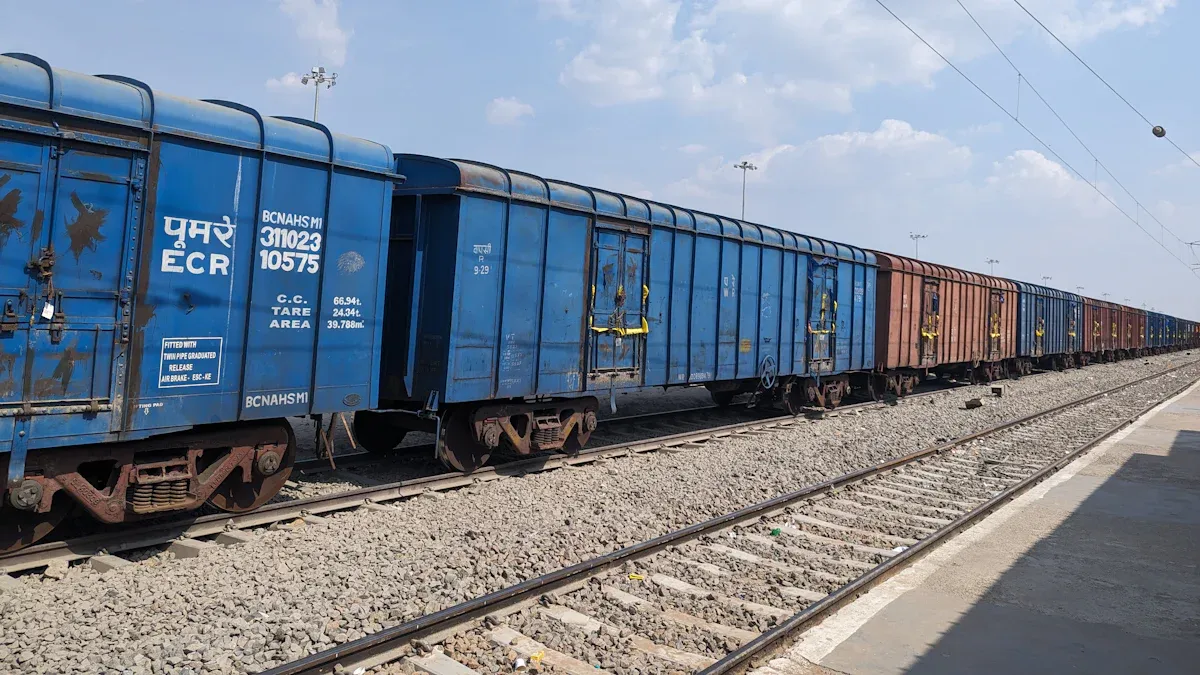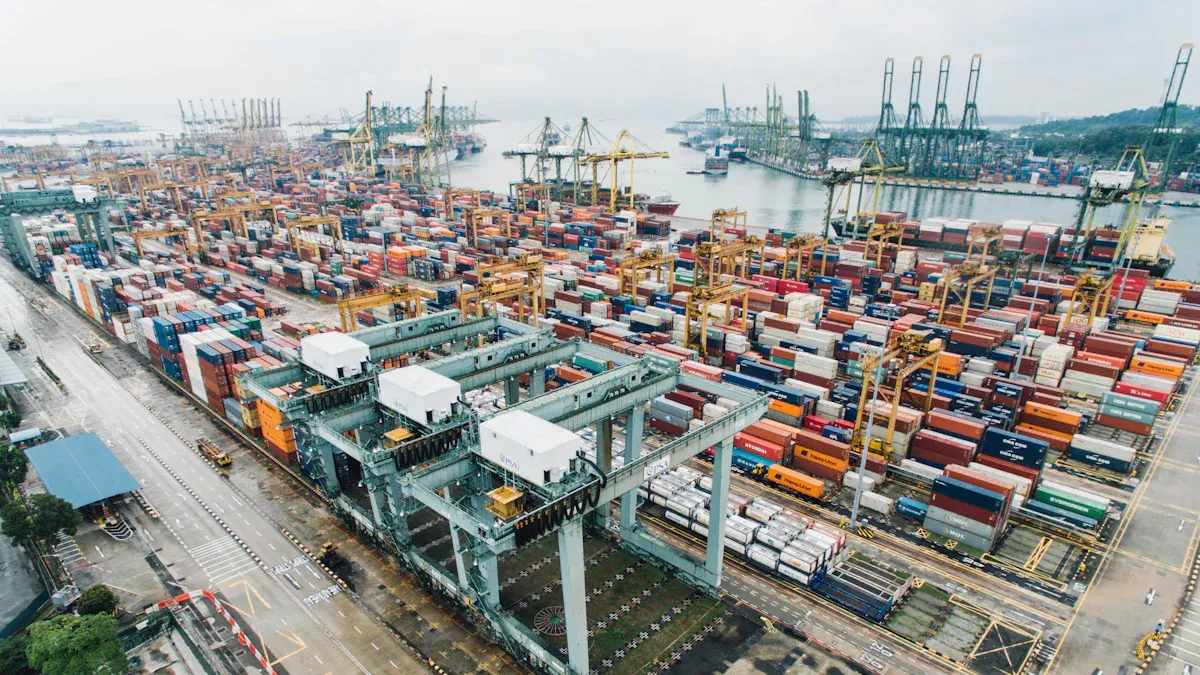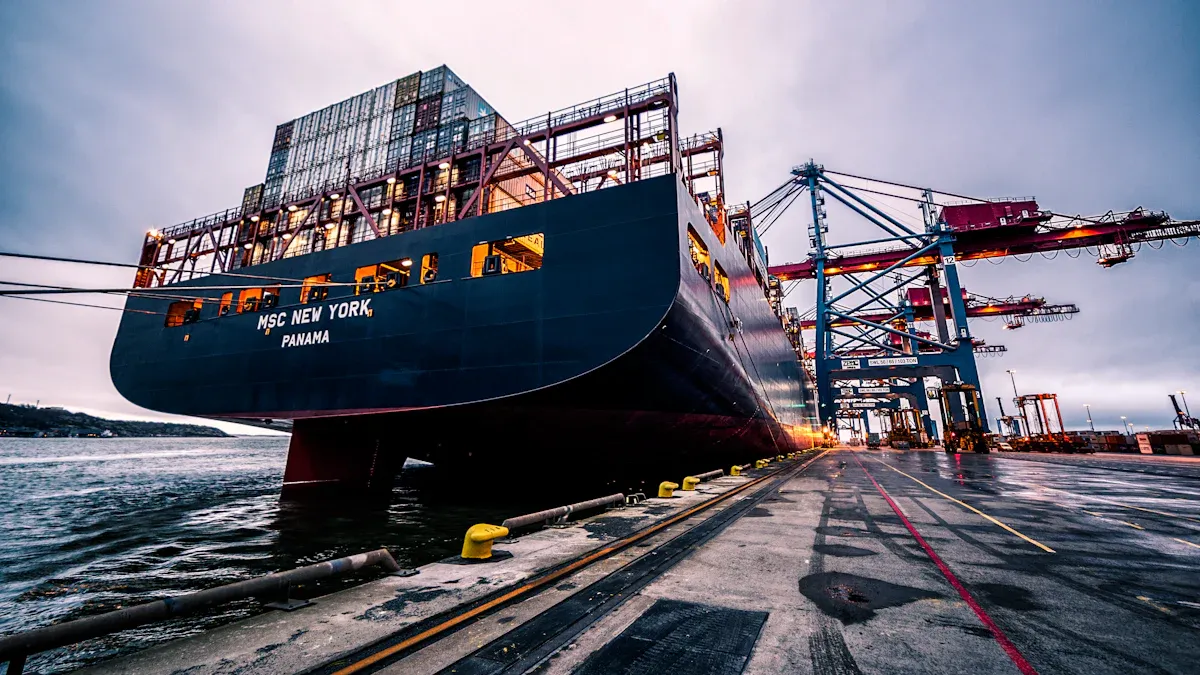Intermodal Freight vs. Single-Mode Freight Transportation Strategies

A global electronics manufacturer faces a critical decision: select intermodal freight or rely on a single transport mode for moving goods between continents. This choice shapes logistics performance by affecting costs, transit times, and reliability. Experts observe that shifts between modes can alter supply chain productivity in both the short and long term. Companies today leverage innovation and technology to improve efficiency. For example, AI-powered inventory management can reduce logistics costs by 15%.
JUSDA’s advanced solutions help businesses make smarter, sustainable transportation choices.
Key Takeaways
Intermodal freight uses multiple transport modes like rail, ship, and truck, offering cost savings and lower emissions for long-distance shipments.
Single-mode freight relies on one transport mode, usually trucks, providing faster and simpler delivery for short or urgent shipments.
Choosing the right freight strategy depends on shipment size, delivery time, cost, flexibility, and environmental goals.
Advanced technology, such as AI and real-time tracking, improves efficiency and decision-making in both freight methods.
Following a structured approach with monitoring, automation, and optimization helps companies reduce costs and boost supply chain performance.
Overview
Definitions
Intermodal Freight refers to the movement of goods in standardized containers using two or more types of transportation, such as ships, trains, and trucks. According to Investopedia, these containers follow international size standards, which allows them to transfer between different vehicles without unloading the cargo. Maersk explains that intermodal shipping uses sealed containers that stay closed during transfers, improving security and reducing damage. Intermodal Freight usually involves separate contracts with different carriers for each part of the journey.
Single-mode freight, often called truckload shipping, uses only one type of transportation from the starting point to the destination. This method relies on a single carrier and contract, making it easier to manage. The cargo does not switch vehicles or modes during transit.
Key Differences
The freight market is changing. Shippers and carriers are adapting their strategies to handle new challenges and opportunities:
Shippers are using more transportation modes and securing better rates in advance.
Many shippers are building stronger partnerships with core carriers and using advanced forecasting tools.
Carriers are focusing on fleet optimization instead of expansion.
Sustainability is becoming more important, with many shippers choosing greener carriers.
The market is shifting from long-term contracts to short-term, flexible solutions.
The table below highlights the main differences between Intermodal Freight and single-mode freight strategies:
Aspect | Intermodal Freight Strategy | Single-Mode (Truckload) Freight Strategy |
|---|---|---|
Transportation Modes | Uses multiple modes (e.g., rail + truck) with containerization | Uses a single mode (truck) directly from origin to destination |
Environmental Impact | Lower carbon emissions due to rail efficiency and reduced fuel consumption | Higher emissions, more fuel consumption due to truck-only transport |
Cost Efficiency | Cost-effective for long-distance hauls due to rail energy efficiency | More cost-effective for shorter distances but can be costly for long hauls |
Transit Time | Predictable transit times with optimized schedules, may be longer than direct truckload | Generally faster for short distances, but susceptible to delays (traffic, weather) |
Cargo Handling | Reduced handling points, lowering damage risk | Direct handling but higher risk of damage during transit |
Operational Complexity | Requires coordination between multiple carriers and contracts | Simpler, single contract and carrier |
Suitability | Best for long hauls, sustainability goals, and cost savings | Best for time-sensitive or short-distance shipments |
Intermodal Freight offers flexibility and cost savings for long distances but requires more coordination. Single-mode freight provides simplicity and speed for short hauls but may not be as efficient for longer routes or sustainability goals.
Intermodal Freight

How It Works
Intermodal Freight uses a combination of transportation modes, such as rail, ship, and truck, to move goods from origin to destination. The process begins with loading cargo into standardized containers at the shipper’s facility. These containers remain sealed as they transfer between different vehicles. For example, a container may travel by truck to a rail terminal, continue by train across a region, and then move by ship to another country. At each transfer point, workers do not unload the cargo itself. This method reduces handling, lowers the risk of damage, and improves security.
A typical logistic flow chart for Intermodal Freight shows the sequence of operations. The chart links each mode—truck, rail, and ship—using workflow icons to represent the movement. This visual model helps companies understand how goods move efficiently through the supply chain. The process supports faster transport and better coordination between carriers.
Benefits
Intermodal Freight offers several advantages for modern logistics. Companies benefit from reduced cargo handling, which lowers the chance of loss or damage. Improved security comes from keeping containers sealed during transfers. Many businesses see faster delivery times because of optimized schedules and fewer delays.
Case studies from Europe and the United States show that Intermodal Freight can match or exceed road transport in reliability and cost. For example, the InnovaTrain project demonstrated that flexible, door-to-door services using rail and truck can compete directly with traditional trucking. In Memphis, public-private partnerships have helped build efficient intermodal facilities, making the region a global leader in freight movement.
Empirical research supports the economic and environmental benefits of Intermodal Freight. Studies show that up to 50% of heavy goods traffic could shift from road to rail if networks are dense and services are competitive. Digital platforms also help automate processes and improve efficiency.
Note: Intermodal Freight continues to grow worldwide. The table below highlights key market trends:
Metric/Segment | Data/Value |
|---|---|
Revenue Forecast (2030) | |
CAGR (2024-2030) | 12.1% |
Largest Service Segment | Transportation & Warehousing (35.6%) |
Largest Regional Market Share | North America (35.6% in 2023) |
Fastest Growing Region | Asia Pacific (13.0% CAGR in 2023) |
Single-Mode Freight
How It Works
Single-mode freight transportation uses one type of vehicle to move goods from the starting point to the final destination. Most often, companies choose trucks for this method. The process begins when a carrier picks up cargo at the shipper’s facility. The same truck then travels directly to the receiver’s location. No transfers or mode changes occur during the journey. This approach keeps the shipment on a single contract and with one carrier, making management simple.
Shipping companies often use advanced route planning tools to select the fastest or most reliable path. They monitor traffic, weather, and road conditions to avoid delays. Many carriers use GPS tracking and digital platforms to provide real-time updates to customers. This transparency helps shippers and receivers plan for arrivals and manage inventory more effectively.
Single-mode freight works best for short to medium distances. It also suits time-sensitive shipments that need direct delivery without stops or transfers.
Benefits
Single-mode freight offers several clear advantages for businesses:
Simplicity: Companies deal with only one carrier and one contract. This reduces paperwork and lowers the risk of miscommunication.
Speed: Direct routes mean faster delivery times, especially for regional or local shipments.
Reliability: Fewer handling points reduce the chance of cargo damage or loss.
Flexibility: Carriers can adjust schedules quickly to meet urgent delivery needs.
Recent studies show that cost, efficiency, and performance in single-mode freight depend on factors like shipping cost, travel time, and reliability. Researchers use freight mode choice models to measure these variables. Shipping cost includes a base charge plus a rate based on shipment size. Travel time combines driving time and any delays. Machine learning models, such as CatBoost and Random Forest, help predict delivery outcomes and reveal how shipment weight, distance, and value affect performance.
Scholarly research also validates cost and efficiency measurement methods in single-mode freight. For example, the Balanced Scorecard and Data Envelopment Analysis help companies track financial results, customer service, and operational processes. These tools guide carriers in managing costs, improving service, and optimizing routes. Studies confirm that careful cost management and efficiency tracking lead to better performance in the trucking industry.
🚚 Single-mode freight remains a popular choice for businesses that value speed, simplicity, and direct control over their shipments.
Comparison

Cost
Cost remains a major factor when choosing between intermodal and single-mode freight strategies. Many studies compare the expenses of moving goods by different modes. Intermodal options, especially those using maritime and rail, often provide significant savings over long distances or in regions close to ports. The table below summarizes findings from several corridors:
Corridor (Region) | Geographic Characteristics | Numeric Cost Difference (%) | Interpretation |
|---|---|---|---|
Northern Europe | Close to coast, access to multimodal networks | Maritime multimodal transport costs less than road in competitive port areas | |
Spain-Italy Corridor | Shorter maritime vs. road distance | 46% to 57% cheaper | Maritime multimodal much cheaper due to geographic advantage |
Spain-Italy Corridor | Integrated modes, similar distances | At least 30% cheaper | Integrated maritime multimodal is at least 30% less expensive |
Various European Corridors | Port proximity varies | 12.3% to 32.8% cheaper | Road costs higher by 12.3% to 32.8% compared to maritime intermodal |
Taiwan Corridor | Ports close, distances similar | -19.2% (road cheaper) | Road transport costs 19.2% less than maritime intermodal in this corridor |
Java Island, Indonesia | Medium corridor, port proximity varies | Road cheaper overall | Maritime intermodal competitive only for long distances and port proximity |
Researchers calculate these differences by considering trip time, docking, container costs, staff, fuel, and maintenance. Intermodal Freight becomes more cost-effective as distance increases or when ports are nearby. For short hauls or where ports are not accessible, single-mode road transport may offer lower costs.
Efficiency
Efficiency measures how well a freight system moves goods with minimal waste or delay. Intermodal Freight can deliver high efficiency on long routes by combining the strengths of each mode. Rail and maritime transport handle large volumes with less fuel per ton, while trucks provide flexible pickup and delivery. This combination reduces bottlenecks and improves scheduling.
Single-mode freight, usually by truck, excels in direct, short-distance deliveries. Trucks can go door-to-door without transfers, which speeds up shipments and reduces handling. However, for long distances, trucks face higher fuel use and more exposure to traffic or weather delays.
Companies often use digital tools and real-time tracking to boost efficiency in both systems. These technologies help carriers plan routes, monitor shipments, and respond quickly to disruptions.
Flexibility
Flexibility describes how easily a freight system adapts to changes or disruptions. Recent advances in digital twins and AI models have improved flexibility for both intermodal and single-mode freight. These tools create virtual copies of physical assets, allowing real-time monitoring and quick decision-making.
Intermodal Freight stands out for its ability to shift between modes when needed. For example, if a rail line faces a delay, goods can transfer to trucks or ships. AI-powered systems simulate disruptions and suggest the best alternative routes. This dynamic approach increases resilience and keeps goods moving even during unexpected events.
Single-mode freight offers flexibility in scheduling and routing, especially for urgent or local deliveries. Trucks can reroute quickly around traffic or road closures. However, they lack the modal shift options available in intermodal systems.
Environmental Impact
Environmental impact has become a key concern for shippers and carriers. Intermodal Freight, especially when using rail or maritime segments, produces fewer greenhouse gas emissions than truck-only transport. The table below compares emissions, cost, and transit time for different modes:
Freight Mode | Transit Time (days) | Cost (USD) | Greenhouse Gas Emissions (% relative to truck-only) |
|---|---|---|---|
Truck-only | 3-5 | 1,500 | 100% |
Rail-only | 7-10 | 800 | 40% |
Intermodal (Truck+Rail) | 5-7 | 1,000 | 70% |
A study by the National Renewable Energy Laboratory found that intermodal transportation can cut fuel use by up to 30% compared to truck-only freight. Intermodal trains can carry the same load as about 280 trucks, and rail moves one ton of freight an average of 473 miles on a single gallon of fuel. Rail is 1.5 to 5 times more energy efficient than trucking. By shifting freight from trucks to rail, companies reduce greenhouse gas emissions and air pollution. Intermodal also lessens the need for new highways, helping preserve natural landscapes.
Risk
Risk in freight transport includes disruptions, delays, and vulnerabilities in the network. Studies use simulations and network analysis to identify weak points in both intermodal and single-mode systems. For rail and intermodal networks, critical terminals or nodes can become bottlenecks. If a key terminal faces a disruption, such as a natural disaster or targeted attack, the entire network may slow down or stop. Researchers use models to plan for these events and suggest ways to recover quickly.
Single-mode freight, especially trucking, faces risks from road conditions, weather, and traffic. While trucks can reroute around some problems, they remain vulnerable to large-scale disruptions like highway closures or severe storms.
Effective risk management relies on early-warning systems, contingency planning, and resilient infrastructure. Companies that invest in these strategies can reduce downtime and protect their supply chains.
JUSDA Solutions
Industry Applications
JUSDA delivers tailored logistics solutions for a wide range of industries. The company supports sectors such as automotive, electronics manufacturing, retail, and e-commerce. Each industry faces unique challenges. For example, automotive companies often struggle with outdated processes and poor data visibility. JUSDA’s platform helps these businesses by improving inventory management and reducing lead times. Electronics manufacturers benefit from advanced analytics and centralized data tracking. This approach increases supply chain agility and lowers inventory costs. Retail and e-commerce companies need fast order fulfillment and strong sustainability practices. JUSDA automates order processing and shipment tracking. This leads to faster deliveries and better compliance with environmental standards.
JUSDA’s 8 core products cover air, land, sea, and rail transport. The company also offers cloud warehousing, consolidation, and foreign trade services. These products allow clients to choose the best mix of transport modes for their needs. JUSDA’s solutions help businesses save money, improve efficiency, and meet industry demands.
A real-world example comes from Sharp, a global electronics manufacturer. Sharp partnered with JUSDA to optimize its supply chain. The result was a 20% reduction in logistics costs, a 70% decrease in labor costs, and a 30% improvement in delivery times. This case shows how JUSDA’s expertise brings measurable benefits.
Technology Integration
JUSDA uses advanced technology to drive innovation and efficiency. The JusLink Smart Supply Chain platform combines AI, IoT, and big data analytics. This platform optimizes routes, schedules, and resource allocation. Companies see improved operational efficiency and lower lead times. The system also supports eco-friendly transport by planning routes that reduce emissions.

JUSDA Solutions
To provide you with professional solutions and quotations.
JUSDA’s technology gives clients real-time visibility into their shipments. Automated systems track inventory and shipments across all modes of transport. This transparency helps businesses respond quickly to changes and keep customers satisfied. The platform’s data-driven approach ensures that every shipment moves in the most efficient way possible.
JUSDA’s global network and technology integration set it apart as a leader in supply chain management. The company continues to help clients achieve cost savings, operational excellence, and sustainability goals.
Decision Guide
Key Factors
Choosing the right freight transportation strategy depends on several important factors. Companies must consider the nature of their goods, delivery requirements, and overall business goals. The table below summarizes the main metrics that influence this decision:
Key Factor / Metric | Description / Components |
|---|---|
Customers/Suppliers Density & Distance | Location and accessibility of suppliers and customers, which affect mode choice and delivery timing. |
Shipment Size | Weight, shape, and packaging of goods, which determine the best transport method. |
Product Characteristics | Perishability, value, and special handling needs, such as temperature control or fragility. |
Delivery Time | Total time needed for goods to reach their destination, especially for urgent shipments. |
Total Cost | Includes transportation, handling, and information system expenses. |
Flexibility | Ability to adjust to changes in demand, vehicle capacity, or routes. |
Safety Criteria | Risk of damage or accidents during transit. |
Companies also track performance using metrics like on-time delivery, order cycle time, cost per order, and inventory accuracy. These indicators help businesses measure reliability, speed, and cost-effectiveness.
JUSDA’s advanced analytics and digital platforms support decision-making by providing real-time data on these factors. The JusLink platform, for example, uses AI and big data to optimize routes, monitor shipments, and improve inventory turnover. This technology helps companies select the most efficient and cost-effective freight strategy for their needs.
When to Choose Intermodal Freight
Intermodal Freight works best for companies that need to move large shipments over long distances. This strategy combines different transportation modes, such as rail, truck, and ship, to take advantage of each mode’s strengths. Decision-making frameworks like NODUS, LAMBIT, and SIMBA analyze traffic flows, costs, and environmental impacts to show when intermodal options are most competitive. These models help companies identify the best terminal locations, simulate operational scenarios, and compare costs with single-mode transport.
Businesses should consider Intermodal Freight when they want to:
Lower transportation costs for long hauls.
Reduce greenhouse gas emissions and support sustainability goals.
Move goods that do not require urgent delivery but benefit from secure, sealed containers.
Adapt quickly to disruptions by shifting between modes.
Take advantage of subsidies or optimized terminal locations.
A Belgian case study showed that subsidies and well-placed terminals can make intermodal transport more attractive by increasing shipment volumes and reducing external costs. JUSDA’s global network and technology-driven solutions help clients leverage these benefits. The company’s integrated services allow businesses to combine rail, sea, and road transport, ensuring efficient and reliable delivery across continents.
When to Choose Single-Mode
Single-mode freight, often using trucks, is ideal for short-distance shipments or when speed is critical. Research shows that single-mode transport minimizes costs for local or regional deliveries. This method provides direct, peer-to-peer service with no intermediate handling, making it suitable for time-sensitive or high-value goods.
Companies should choose single-mode freight when they need to:
Deliver goods quickly over short distances.
Handle urgent or last-minute shipments.
Move products that require minimal handling or special care.
Simplify logistics with a single carrier and contract.
Respond flexibly to changes in delivery schedules or routes.
JUSDA supports these needs with specialized road transport services, including vehicle matching and regional network optimization. The company’s digital tools help clients plan efficient routes, monitor shipments in real time, and manage costs. For industries like retail, FMCG, and automotive aftermarket, JUSDA’s single-mode solutions ensure fast, reliable, and cost-effective delivery.
Tip: Companies can use JUSDA’s JusLink platform to compare different freight strategies, analyze real-time data, and make informed decisions based on shipment size, urgency, and sustainability targets.
Intermodal and single-mode freight strategies offer distinct advantages. Intermodal freight provides flexibility and cost savings for long hauls, while single-mode freight delivers speed and simplicity for short distances. Companies that align their freight strategy with business goals see measurable results:
AI-powered route optimization improves on-time delivery rates by up to 20%.
Fuel efficiency gains average 15% each year, lowering costs.
Market share can grow by 15% annually with KPI alignment.
JUSDA’s solutions and technology platforms help businesses achieve these outcomes. Consulting JUSDA experts ensures logistics strategies support long-term growth and industry needs.
FAQ
What is the main difference between intermodal and single-mode freight?
Intermodal freight uses two or more transportation modes, such as rail and truck, for one shipment. Single-mode freight uses only one mode, like trucking, from start to finish.
When should a company choose intermodal freight?
Companies should choose intermodal freight for long-distance shipments, cost savings, or when they want to reduce carbon emissions. This method works well for large volumes and non-urgent deliveries.
How does JUSDA support both freight strategies?
JUSDA offers tailored solutions for both intermodal and single-mode freight. The company uses advanced technology, a global network, and industry expertise to optimize routes, reduce costs, and improve delivery times.
What technology does JUSDA use to improve logistics?
JUSDA uses the JusLink platform, which combines AI, IoT, and big data. This technology tracks shipments in real time, plans efficient routes, and helps companies make better logistics decisions.
Can JUSDA help with urgent or special shipments?
Yes. JUSDA provides specialized services for urgent, high-value, or sensitive shipments. The team matches the right transport mode and uses real-time tracking to ensure safe and timely delivery.
See Also
Exploring The Upcoming Trends In LTL Freight Shipping
Complete Handbook For Eco-Friendly Transportation In Supply Chains
Discover The Latest Developments In Sea Freight Logistics 2024
How Innovations Are Transforming Modern Supply Chain Logistics
Best Strategies To Optimize Supply Chains For Reliable Success
